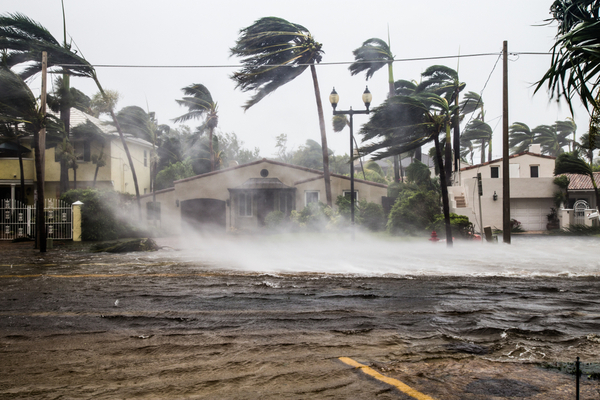In partnership with NOAA, Saildrone Inc. is deploying seven ocean drones to collect data from hurricanes during the 2022 hurricane season with the goal of improving hurricane forecasting. For the first year, two saildrones will track hurricanes in the Gulf of Mexico. According to GTSC’s Homeland Security Today (HS Today), this week, Saildrone launched two saildrones into the Gulf of Mexico, one from St. Petersburg, Florida, and another from Port Aransas, Texas. Five other saildrones were successfully launched this summer from the coast of Jacksonville, Florida and the U.S. Virgin Islands to survey the Atlantic Ocean and Caribbean Sea.
One of the biggest challenges to hurricane forecasting is predicting rapid intensification, when hurricane wind speeds increase at least 35 mph over a 24 hour period. To fully understand how storms intensify, scientists collect data on the exchange of energy between the ocean and atmosphere in the forms of heat and momentum. However, gathering data in this dangerous environment is best accomplished by uncrewed systems.
“This season, NOAA will work with numerous partners to gather oceanic and atmospheric observations using a suite of platforms to monitor the conditions that play a role in hurricane intensity changes,” said John Cortinas, Director of NOAA’s Atlantic Oceanographic and Meteorological Laboratory (AOML). “Storms that intensify rapidly can cause extensive damage and loss of life and real-time observing systems are crucial to better understanding the atmospheric and oceanic processes that lead to the formation and intensification of these hurricanes.”
Five saildrones will operate in the western Atlantic Ocean and Caribbean Sea in areas frequented by tropical storms and hurricanes. Another two saildrones will operate in the Gulf of Mexico, supported by NOAA’s Global Ocean Monitoring and Observing Program.
Saildrones are equipped with a special “hurricane wing,” which looks like a hard sail, to withstand the extreme wind conditions encountered in storms as they gather data from the near-surface ocean and atmosphere in real-time. The data are used to improve our understanding and prediction of tropical cyclone intensity changes and advance our knowledge of the ocean-atmosphere interactions that fuel them.
This year, three of the saildrones will work together with underwater gliders to obtain nearly collocated measurements of the upper ocean and air-sea interface. NOAA and partner scientists will deploy underwater gliders equipped with sensors that measure temperature and salinity down to a half mile below the ocean surface. These gliders provide high-volume, high-resolution data in areas where hurricanes frequently travel. Because of the strong interaction between the ocean and atmosphere during a hurricane’s passage, better representation of the ocean in weather models has led to more accurate intensity forecasts.
As HS Today reports, when opportunities arise, the Saildrones will also coordinate with the small uncrewed aircraft system (sUAS), the Altius-600. Altius-600 drones will be deployed into hurricanes for the first time from NOAA’s Hurricane Hunter aircraft to sample the atmosphere several hundred feet above the ocean surface. The goal is to collect the first coordinated air-sea and atmospheric measurements in a hurricane from uncrewed ocean and aerial drones. The coordination of these instruments simultaneously sampling the ocean and atmosphere near each other in real-time will provide high-resolution data from all parts of the hurricane environment to improve forecaster situational awareness leading to improved forecasts.
“The air-sea interface is where energy is transferred from the warm ocean to hurricanes, but it’s not the whole story,” said Greg Foltz, a NOAA AOML scientist. “Conditions in the subsurface ocean and lower atmosphere affect the rate of energy transfer and the efficiency with which it can fuel a hurricane’s intensification. To understand this flow and exchange of energy, coordinated measurements from multiple ocean-atmosphere observing platforms are needed.”During the 2021 hurricane season, a saildrone collected critical data and the first ever video from inside a category-4 hurricane. A recent study using that data from Hurricane Sam found that saildrone wind measurements taken from Hurricane Sam show excellent consistency with measurements from satellites and a moored buoy, providing confidence in the saildrone’s ability to collect accurate data in the harsh conditions of a major hurricane.
The saildrones provide data directly to NOAA’s AOML and Pacific Marine Environmental Laboratory (PMEL), Saildrone’s scientific partners in this mission. The data will be ingested in the Advanced Weather Interactive Processing System II, a visualization tool, for use by NOAA’s National Hurricane Center forecasters and field offices during the 2022 hurricane season. Data from saildrones and other uncrewed systems will help forecasters better understand the forces that drive hurricanes to warn communities earlier.
—
Photo Credit: FotoKina / Shutterstock.com
